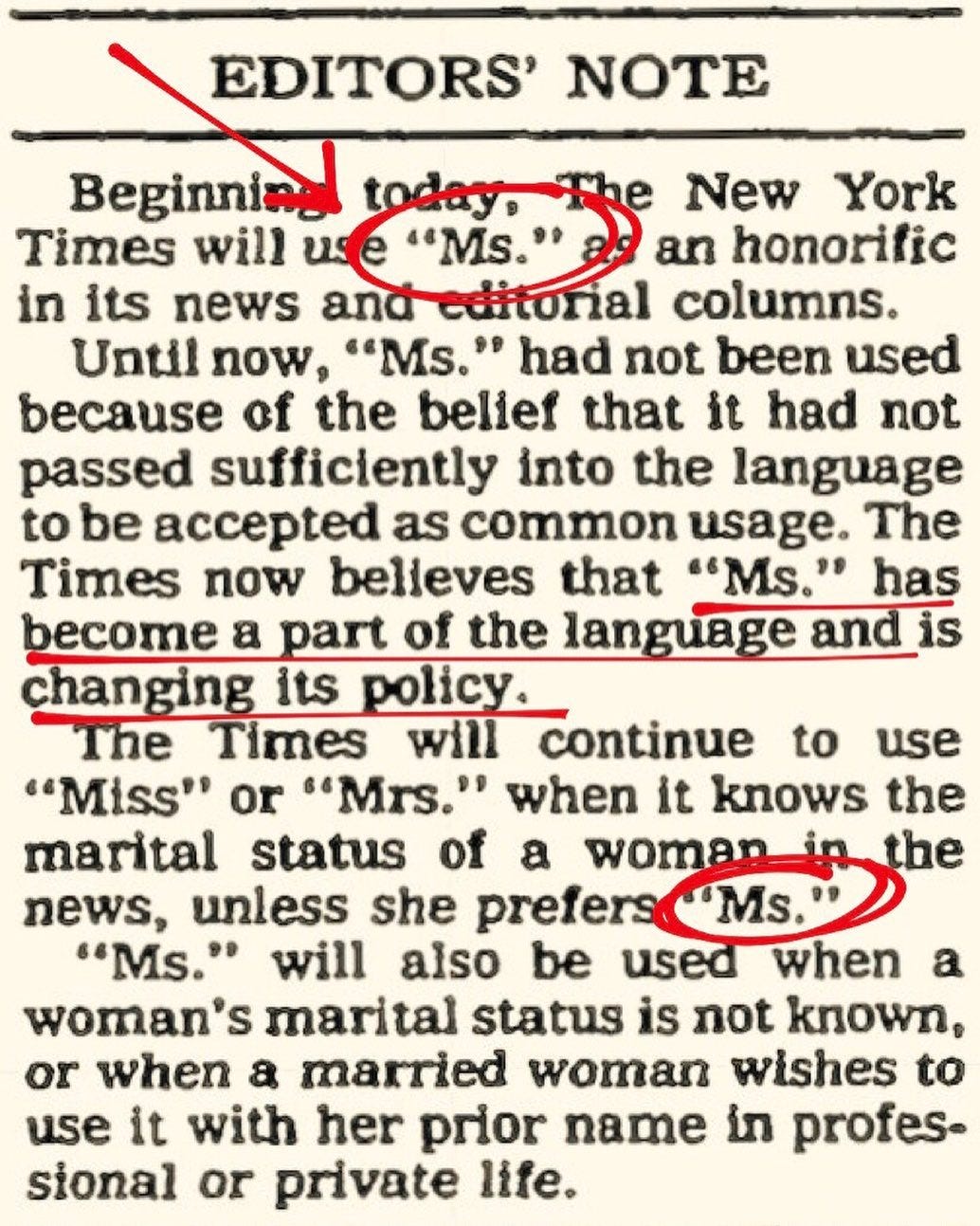When Using ‘Ms.’ Was Radical
On the little-known history, and fight, for a two-letter revolution.
You’re a free subscriber to Wait, Really? For the full experience, become a paying subscriber.
My mom was an elementary school teacher, and for years I remember seeing her write, in her curly teacher-like script, her name on the blackboard for her students: Ms. Mratinich. I learned early that my mother was not "Miss," a term that connoted an unmarried woman, nor was she "Mrs.," a word signifying she was married, though she was married to my father, who had a different last name. My mother was her own person, and a product of her generation — which had fought long and hard to be identified by Ms., a term that, like Mr., did not identify a woman by her marital status.
I didn't think much about "Ms." as an adult until I found myself writing for the New York Times; The Times being one of few remaining publications whose style guidelines mandate the use of honorifics to refer to people: Mr. for men, Ms. for women, Dr. for medical doctors (but not PhDs), and Mx. (a gender neutral honorific) or Mrs. (the married one) for those who request it.
With the exception of the one time this policy came in useful — when I needed to tally up the gender breakdown of Times obituaries, going back nearly 200 years, which the honorifics allowed us to do by algorithm — I have always been irritated by this rule. It felt like a stuffy relic of a different generation, at a publication that was actively trying to shed its stuffy exterior and appeal to younger readers. That, and it required the extra step of verifying the gender of each source, which often had absolutely no relevance to the story.
I've been thinking about "Ms." this month because Ms. magazine, the one founded by Gloria Steinem and named for that honorific, is celebrating its 50th anniversary — and as a result, I got to ask Steinem about the term.
Ms. Magazine's early editors, plus me: Dr. Janet Dewart Bell, Jane O’Reilly, Cathie Black, Letty Cottin Pogrebin, Gloria Steinem (with Ms.'s first issue) and Alice Walker.
As the story goes, the magazine was named "Ms." after Steinem heard a radio interview with a young civil rights worker in New York, Sheila Michaels, who argued for the use of the term after spotting it on a piece of mail sent, which at first she thought was a typo.
Rejected titles included Bimbo (ironically), Sojourner (named for Sojourner Truth), and Sisters (like sisterhood, though the editors worried people might think it was a magazine for nuns). Ms. won out, which helped push the term into common usage — including, in 1972, its adoption by the American Heritage School Dictionary.
Ms. continued to make its way into the mainstream into the 1970s and early 1980s, when I was born. My mom — early adopter! — began using it in 1970, when she got her first teaching job in Seattle.
And yet (and perhaps I shouldn't be surprised here) the New York Times remained stubbornly resistant to the use of the term into the mid-1980s, even in the face of protests from Steinem and the Ms. editors themselves, who picketed the newspaper over it. Which meant that for more than a decade, Steinem — by then the most prominent leader of the women’s movement, and whose name appeared regularly in the newspaper — was referred to as “Miss Steinem of Ms. Magazine.” She still chuckles when she says this.
"Ms." finally prevailed in the paper of record in 1986, with an editor's note declaring the term had finally "passed sufficiently into the language to be accepted as common usage."
As Steinem tells it, on the night the change was formally made, she and her fellow Ms. editors showed up unannounced in the newsroom with a bouquet of flowers for the editor, A.M. Rosenthal. To which Rosenthal replied: “If I'd known it mattered so much to you, I would've done it sooner!"
Somehow I find that hard to believe.
What I’m Reading:
Covid finally got me so mostly I've been dozing this week, but here are three pieces that have stuck with me:
'They, Then and Now.' I loved this piece by Brock Colyer in New York Magazine about the performance politics of gender pronouns and who they serve.
The 'Pro-Life Generation': Since we're talking about language, I was stunned to see these young women describing themselves as "feminists," "leftists" and "atheists" — who aim to eradicate abortion "through an anti-Capitalist lens" — in this article about a new generation of anti-abortion activists. What happens when anti-abortion activists coopt the language of social justice?
Scenes from an Open Marriage. Not about language but a fascinating and beautifully written essay on marriage.
From the Archives, Ms. Magazine Edition: Robert Redford’s Back
Ms. Magazine, October 1975
How did Robert Redford’s backside end up on the cover of Ms. Magazine in 1975? Simple: His PR firm shared an office with Ms., and they needed a male model for their "Special Issue On Men." “Several of us had taken the elevator with Robert Redford, and we knew that he had a really nice back,” Letty Cottin Pogrebin, one of Ms.'s founding editors, told me recently. “So we asked if we could borrow it, and we did.”
⏩ Forward this newsletter to a friend or sign up to get it to your inbox.
💬 Have thoughts to share? Email me at supwaitreally@gmail.com. (You can also just reply to this email.)
🙋🏻♀️ Follow me on Instagram or learn more about my writing and books here.




